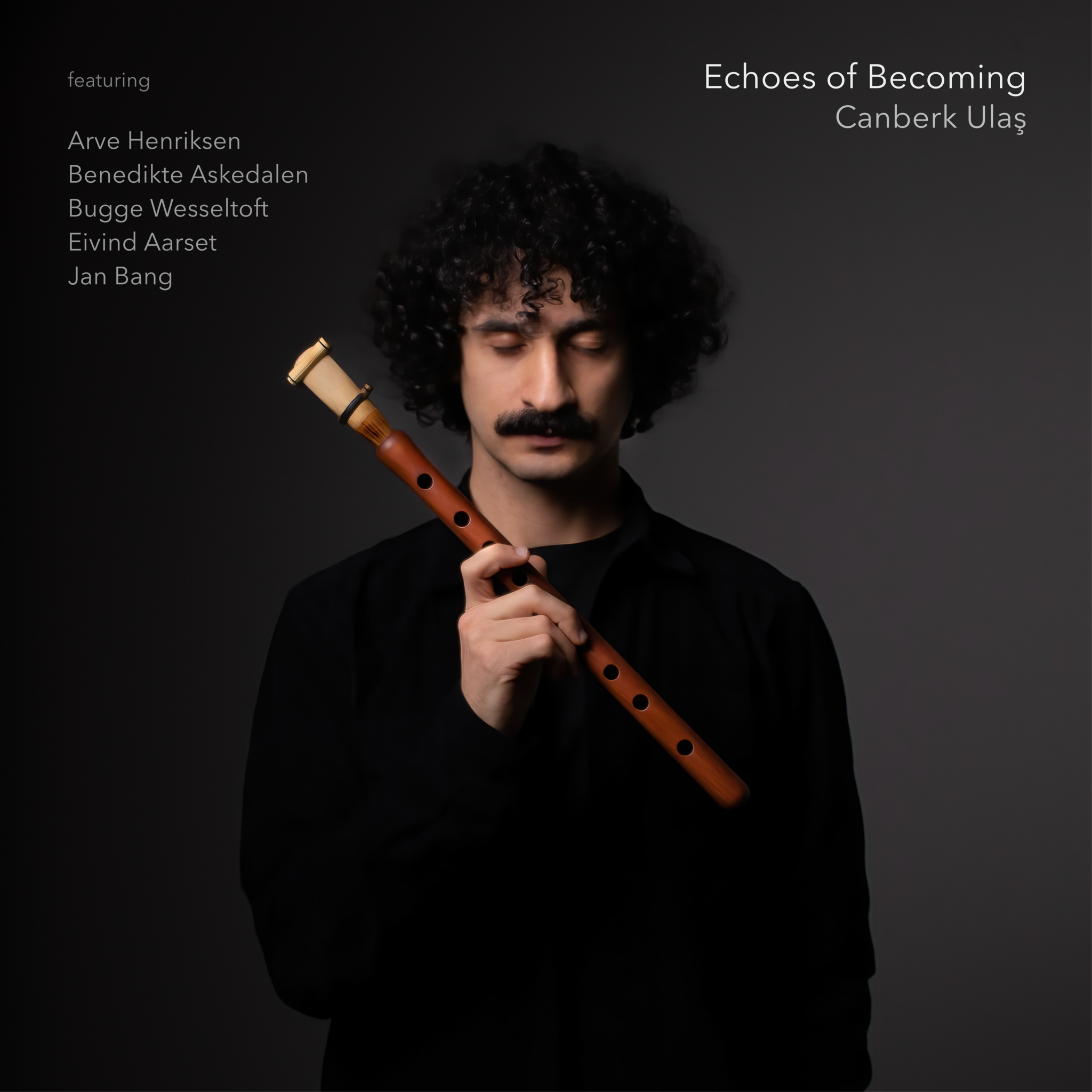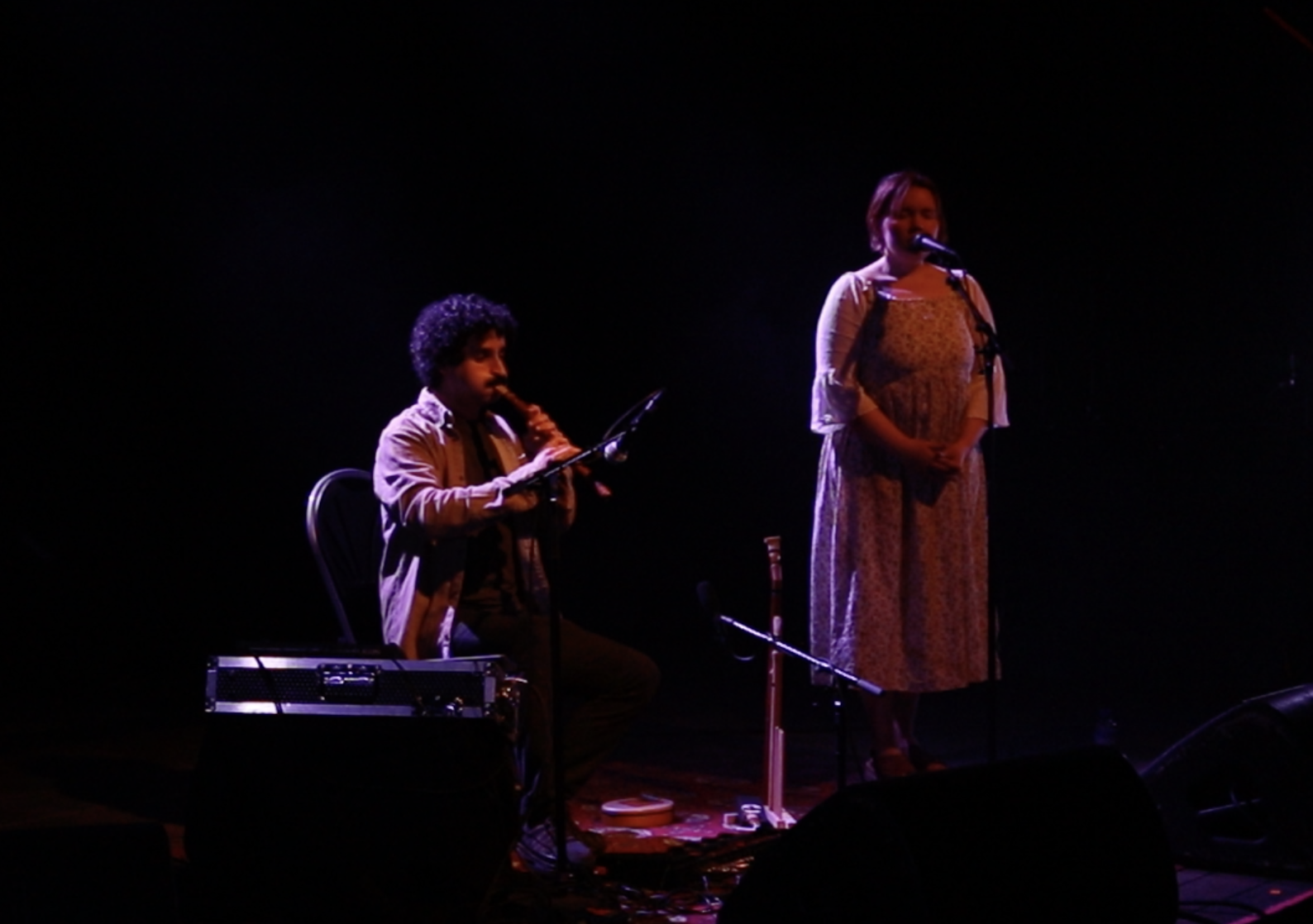Unsynchronised loops: Not only on these tracks below but also in the performances that I had a chance to experience composing with unsynchronised loops with Jan Bang, Eivind Aarset and Erik Honore in
- Punkt Festival - Kristiansand, Norway - September 2022
- Banlieues Bleues Festival - Paris, France - April 2022.
The Whispering Forest (Aarset, 2012)
Satellite Sister (Bang, 2022)
Purplebright (Bang, Aarset, 2020)
Nightspell (Bang, Aarset, 2020)
Separation via the use of reverb: During my research, I discovered the separation effect of the reverb. Even if I play notes that are very close notes on top of each other, it is possible to make them sound separated, without clash if I give wet reverb to one, while the other one is dry. The track below is a good example of it.
Nightspell (Bang, Aarset, 2020)
Music produced, arranged and mixed by Canberk Ulaş
Released from Jazzland Recordings on February 2024
Mastered by Murat Çolak at GERYON in New York
Cover photograph and cover design by Canberk Ulaş
Inside photograph by Anders Magnus
All the compositions by Canberk Ulaş except Track 6 is by Ulaş, Eivind Aarset and Jan Bang
Lyrics in Track 5 by Canberk Ulaş
Spoken words in Track 4 are from the book “The Notebooks of Malte Laurids Brigge” by Rainer Maria Rilke; translated from Turkish to English by Canberk Ulaş
Spoken words in Track 7 are from the Clarissa Pinkola Estés, Kurtlarla Koşan Kadınlar, translated by Hakan Atalay, Ayrıntı Yayınları
Duduk, electronics, sansula, sampling, upright piano, keyboard: Canberk Ulaş
Trumpet: Arve Henriksen (Track 4)
Electric guitar: Eivind Aarset (Track 6)
Live sampling: Jan Bang (Track 6)
Vocals: Benedikte Kløw Askedalen (Track 5)
Grand piano: Bugge Wesseltoft (Track 8)
Spoken words: Kieron Concannon (Track 4)
Sampled spoken words: Deniz Ulkat (Track 7)
Duduk, sansula, upright piano recordings are done by Canberk Ulaş in Gothenburg and Hindås, Sweden
Track 6 is recorded by Jan Bang at Punkt Studio in Kristiansand, Norway
Trumpet in Track 4 is recorded by Arve Henriksen in Mölnlycke, Sweden
Spoken words in Track 4 is recorded by Kieron Concannon in Ballyloughnane, Ireland
Piano in Track 8 is recorded by Bugge Wesseltoft in Oslo, Norway
Vocals in Track 5 is recorded by Benedikte Kløw Askedalen in Oslo, Norway
1. Broken
In this composition, I use a technique in which I play the piano with my right hand and the duduk with my left. Although the recording process for this track included some overdubs initially and ultimately, it was originally intended for live performance. Therefore, I deliberately prepared a simple and restrained melody, ensuring its suitability for live renditions.
Life often presents us with many breaks and setbacks. But these ruptures serve as opportunities for introspection, resilience, and ultimately growth. The deep theme of starting a new story more strongly is what underpins the album summed up in the opening track "Broken".
2. Pattern in Heritage
This composition comprises two distinct movements: the first is characterized by gentle, simplistic motifs that provide auditory solace, and the second is marked by friction and tension.
The first part: 00.00 - 03.30
The second part: 03.30 - 06.36
In the initial segment, from 00:00 to 03:30, I've woven loops, harmonies across various registers, and reverb effects. Employing the duduk, I've tried to explore different tonal ranges while ensuring a comforting listening experience. I've introduced a wet reverb effect in the loop that starts from 00:15 onwards to separate the layers that are in the same range.
Drawing from insights gleaned from discussions with Jan Bang, I've sought to infuse an element of unpredictability into both composition and performance. While my proficiency as a duduk player may incline me toward creating somber, introspective atmospheres, I'm open to pushing boundaries and venturing into new artistic territories. Thus, the second movement assumes importance as exploring extended techniques and electronic treatments.
Conceptually, the recurring loops and motifs within the composition serve as metaphors for inherited behavioral and mindset patterns, often passed down unconsciously through generations. Despite potentially leading to issues in life, these patterns foster a sense of harmony through repetition. However, the second part symbolizes an effort to disrupt and transcend these ingrained patterns, thereby catalyzing personal growth and transformation.
3. Outside Selfland
In this composition, I incorporate various advanced techniques and digital effects, but a particularly notable element is the simultaneous performance of two duduks, introducing tension and interplay via interference within the music.
"Outside Selfland" represents a bold endeavor aimed at disrupting ingrained patterns inherited from our cultural heritage. It urges us to transcend the confines of our possessions, societal roles, and reputations. Embarking on this journey entails delving into the depths of the unknown and unfamiliar, which can evoke feelings of trepidation and uncertainty. However, it also promises an exhilarating voyage of self-discovery, offering the potential for personal growth and the realization of our true potential.
4. Ritual
This ceremony marks a pivotal moment in the journey, signifying the abandonment of material possessions, comfort zones, and societal reputations. Drawing inspiration from various sources, including the profound words of German poet Rainer Maria Rilke from his work "The Notebooks of Malte Laurids Brigge":
"If one day, you have a name that everyone knows, raise your hand to the sky at midnight and ask God for a name new that no one knows."
This poignant passage, delivered by my Irish friend and duduk student Kieron Concannon in the album, encapsulates the essence of this transformative phase.
I base the composition on a continuous drone note that intertwines two bass lines decorated with harmony and reverb effects. However, instead of using a typical drone sound, I chose to use a looped, glitchy sound. Expanding the soundscape, I perform in duduk's bass range, while esteemed trumpeter Arve Henriksen contributes with his improvisational skills as a guest musician. This departure from the traditional role of duduk underscores the evolving narrative of the composition.
5. I Came From Far Away
This composition holds a significant narrative role within the overarching story, despite its not primary focus on the duduk performance. Adding depth to the album, the enchanting vocals of my esteemed singer friend, Benedikte Kløw Askedalen, grace the tracks, weaving between Turkish and English. The lyrics, penned by myself, recount a tale of resilience—a voyage from the depths of darkness towards the beacon of a new beginning. I played sansula, duduk, keyboard and sampled some extended techniques on sansula to create rhythms.
Lyrics
I came from far away
I came from a fight
I came from far away
I came from the dark
I came from far away
I came from a battle
I came from far away
I came here to make a life again
Çok uzun yoldan geldim
Kavgadan dönüşten
Sana hikayeler getirdim
Umutlarımı yitirdiğim coğrafyadan
I came here to make a life again
6. Kristiansand
This track was collaboratively composed with guitarist Eivind Aarset and producer Jan Bang, stemming from an improvisational process.
Kristiansand, a city in Norway, holds profound significance for me, as it's where I encountered numerous influential individuals who have left an indelible mark on my artistic journey. It was in Kristiansand that I first crossed paths with Eivind and Jan, and it was there that we came together to record this track. Thus, I've aptly titled the piece "Kristiansand" in homage to the city's role in fostering creativity and collaboration.
7. Tired But Not Lost
The composition begins with the sound of a bus, which I sampled. I incorporated fragments of a voice message from my friend Deniz Ulkat, who recited Clarissa P. Estés' "Women Who Run with the Wolves" in Turkish. Over a simple, repetitive piano motif, I improvised on the duduk. Through the inclusion of the bus sample, I aimed to juxtapose noise with minimalist beauty. I use this piano sound as pre-recording in live performances. The title is inspired by the words of the tale of Clarissa P. Estés
8. Greetings to Istanbul
This melody was composed during my time in Istanbul, though it didn't have a name then. Upon relocating to Norway, during my initial individual lesson with Bugge Wesseltoft, we reminisced about Istanbul, a city he holds many memories of. Being a Turkish musician residing in Scandinavia, I wanted to convey my regards to Istanbul through this song, in collaboration with Bugge.
9. A New Beginning
In this composition, I utilize unsynchronized loops alongside duduks playing in both low and high registers, enhanced with harmony and reverb effects, to craft a rich soundscape. I perform a melody on both piano and duduk, with the duduk on the left hand and piano on the right, a technique reminiscent of the first song, "Broken". Ending the piece with this technique creates a sense of closure and familiarity for the audience.
As this marks the concluding track of the project, I bring in several guest musicians and reintroduce the voice of Deniz Ulkat to bid farewell and wrap up the narrative. This addition serves to enhance familiarity and emotional resonance. To ensure cohesion with the tonality of the song, I utilized the Samplr app to adjust the pitch of the guest musicians' recordings.
Every journey's end signifies the potential for a new beginning, which is why this song serves as the project's conclusion. To close one chapter and embark on the next, it's essential to express gratitude and bid farewell to all those who contributed.







